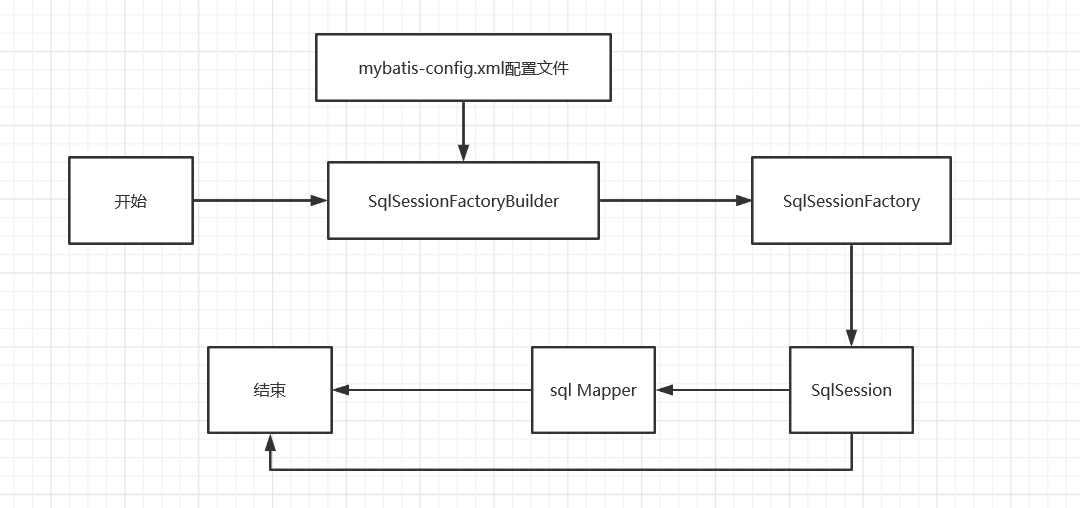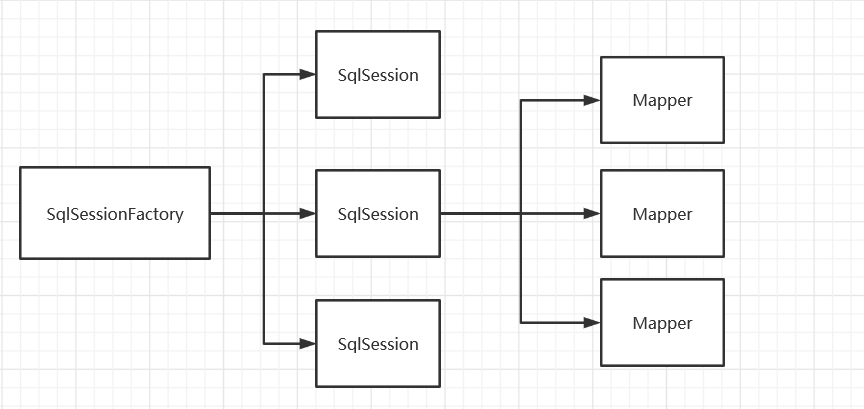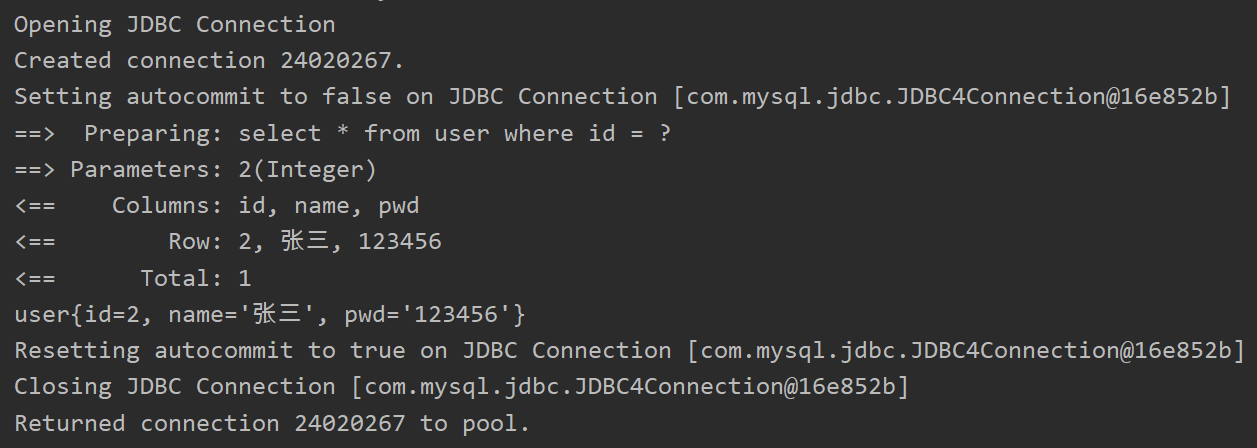Mybatis
结合Mybatis中文文档学习:https://mybatis.org/mybatis-3/zh/index.html
1、简介
1.1、什么是Mybatis?
- MyBatis 是一款优秀的持久层框架,它支持自定义 SQL、存储过程以及高级映射。
- MyBatis免除了几乎所有的 JDBC 代码以及设置参数和获取结果集的工作。
- MyBatis 可以通过简单的 XML 或注解来配置和映射原始类型、接口和 Java POJO(Plain Old Java Objects,普通老式 Java 对象)为数据库中的记录。
- MyBatis 本是apache的一个开源项目iBatis, 2010年这个项目由apache software foundation 迁移到了google code,并且改名为MyBatis 。
- 2013年11月迁移到Github。
如何获取mybatis?
-
Maven仓库
<!-- https://mvnrepository.com/artifact/org.mybatis/mybatis --> <dependency> <groupId>org.mybatis</groupId> <artifactId>mybatis</artifactId> <version>3.4.6</version> </dependency> -
GitHub:
2、第一个Mybatis
2.1、搭建环境
创建一个普通的maven项目,在里面再创建一个普通的maven子项目。
导入依赖
<dependencies>
<!-- Mybatis-->
<dependency>
<groupId>org.mybatis</groupId>
<artifactId>mybatis</artifactId>
<version>3.4.6</version>
</dependency>
<!-- mysql-->
<dependency>
<groupId>mysql</groupId>
<artifactId>mysql-connector-java</artifactId>
<version>5.1.47</version>
</dependency>
<!-- junit-->
<dependency>
<groupId>junit</groupId>
<artifactId>junit</artifactId>
<version>4.12</version>
<scope>test</scope>
</dependency>
</dependencies>
2.2、编写JDBC配置文件
<?xml version="1.0" encoding="UTF-8" ?>
<!DOCTYPE configuration
PUBLIC "-//mybatis.org//DTD Config 3.0//EN"
"http://mybatis.org/dtd/mybatis-3-config.dtd">
<!--configuration核心配置文件-->
<configuration>
<environments default="development">
<environment id="development">
<transactionManager type="JDBC"/>
<dataSource type="POOLED">
<property name="driver" value="com.mysql.jdbc.Driver"/>
<property name="url" value="jdbc:mysql://localhost:3306/mybatis?character=UTF-8&useUnicode=true&useSSL=true"/>
<property name="username" value="root"/>
<property name="password" value="123456"/>
</dataSource>
</environment>
</environments>
</configuration>
2.3、编写工具类
package com.Lv.utils;
import org.apache.ibatis.io.Resources;
import org.apache.ibatis.session.SqlSession;
import org.apache.ibatis.session.SqlSessionFactory;
import org.apache.ibatis.session.SqlSessionFactoryBuilder;
import java.io.IOException;
import java.io.InputStream;
/**
* @Author: Lv
* @Description:工具类
* @Vision: 1.0
* @Date: Created in 18:41 2020/7/28
*/
public class MybatisUtils {
private static SqlSessionFactory sqlSessionFactory;
static {
try {
//获取sqlSessionFactory对象
String resource = "com.Lv.resource/mybatis-config.xml";
InputStream inputStream = Resources.getResourceAsStream(resource);
sqlSessionFactory = new SqlSessionFactoryBuilder().build(inputStream);
} catch (IOException e) {
e.printStackTrace();
}
}
//获取sqlSessionFactory
public SqlSession getSqlSession(){
return sqlSessionFactory.openSession();
}
}
2.4、实体类
2.5、Dao层接口
public interface UserDao {
List<User> getUser();
}
2.6、Dao层实现类由原来的UserDaoImpl变为xml配置文件
<?xml version="1.0" encoding="UTF-8" ?>
<!DOCTYPE mapper
PUBLIC "-//mybatis.org//DTD Mapper 3.0//EN"
"http://mybatis.org/dtd/mybatis-3-mapper.dtd">
<mapper namespace="com.Lv.dao.UserDao">
<select id="getUser" resultType="com.Lv.User">
SELECT * FROM `user`
</select>
</mapper>
2.7、测试
注意点:每一个Mapper.xml文件都需在核心配置文件中配置
org.apache.ibatis.binding.BindingException: Type interface com.Lv.dao.UserDao is not known to the MapperRegistry.
Maven中资源生成或导出失败问题
java.lang.ExceptionInInitializerError
<build>
<resources>
<resource>
<directory>src/main/resources</directory>
<includes>
<include>**/*.properties</include>
<include>**/*.xml</include>
</includes>
<filtering>true</filtering>
</resource>
<resource>
<directory>src/main/java</directory>
<includes>
<include>**/*.properties</include>
<include>**/*.xml</include>
</includes>
<filtering>true</filtering>
</resource>
</resources>
</build>
3、CRUD
1、namespace
namespace中的包要和Dao/Mapper的包名一致
2、select
选择,查询语句:
- id:就是对应namespace中的方法名;
- resultType:SQL语句的返回值
- parameterType:参数类型
编写接口
//根据id查询用户
User getUser(int id);
在UserMapper.xml中配置
<select id="getUser" parameterType="int" resultType="com.Lv.pojo.User">
select * from user where id=#{id}
</select>
测试
@Test
public void userTest(){
SqlSession sqlSession = MybatisUtils.getSqlSession();
UserMapper mapper = sqlSession.getMapper(UserMapper.class);
User user = mapper.getUser(2);
System.out.println(user);
sqlSession.close();
}
3、insert
<insert id="addUser" parameterType="com.Lv.pojo.User">
insert into user values (#{id},#{name},#{pwd})
</insert>
@Test
public void addUserTest(){
SqlSession sqlSession = MybatisUtils.getSqlSession();
UserMapper mapper = sqlSession.getMapper(UserMapper.class);
int i = mapper.addUser(new User(4, "丽丽", "555555555"));
//增删改需要提交事务
sqlSession.commit();
sqlSession.close();
}
4、update
<update id="updateUser" parameterType="com.Lv.pojo.User">
update user set name=#{name},pwd=#{pwd} where id=#{id}
</update>
5、delete
<delete id="deleteUser" parameterType="int">
delete from user where id=#{id}
</delete>
注意点:增删改中需要提交事务
4、万能的Map
假设,我们的实体类,或者数据库中的表,字段或者参数过多,我们应当考虑使用Map
//使用Map传参增加加一个用户
int addUser2(Map<String,Object> map);
<insert id="addUser2" parameterType="Map">
insert into user values (#{userid},#{username},#{userpwd})
</insert>
@Test
public void addUser2Test(){
SqlSession sqlSession = MybatisUtils.getSqlSession();
UserMapper mapper = sqlSession.getMapper(UserMapper.class);
Map<String,Object> map = new HashMap<String, Object>();
map.put("userid",5);
map.put("username","天天");
map.put("userpwd","123456");
int i = mapper.addUser2(map);
sqlSession.commit();
sqlSession.close();
}
Map传递参数,在SQL中取key即可
对象传递参数,直接在SQL中取对象的属性即可
参数只有一个基本数据类型的情况下,可以直接在SQL中取到,即参数类型可以忽略不写
多个参数用Map或者注解
4、配置解析
1、核心配置文件
- mybatis-config.xml
- MyBatis的配置文件包含了会深深影响MyBatis行为的设置和属性信息。
configuration(配置)
properties(属性)
settings(设置)
typeAliases(类型别名)
typeHandlers(类型处理器)
objectFactory(对象工厂)
plugins(插件)
environments(环境配置)
environment(环境变量)
transactionManager(事务管理器)
dataSource(数据源)
databaseIdProvider(数据库厂商标识)
mappers(映射器)
2、环境配置(environments)
- MyBatis 可以配置成适应多种环境
- 不过要记住:尽管可以配置多个环境,但每个 SqlSessionFactory实例只能选择一种环境。
Mybatis默认的事务管理器是JDBC,连接池:POOLED
3、属性(properties)
编写一个配置文件
driver=com.mysql.jdbc.Driver
url=jdbc:mysql://localhost:3306/mybatis?character=UTF-8&useUnicode=true&useSSL=true
username=root
password=123456
在核心配置文件中引入
注意:配置文件中个标签有顺序,严格按照顺序来

<?xml version="1.0" encoding="UTF-8" ?>
<!DOCTYPE configuration
PUBLIC "-//mybatis.org//DTD Config 3.0//EN"
"http://mybatis.org/dtd/mybatis-3-config.dtd">
<configuration>
<properties resource="db.properties">
<property name="username" value="aabb"/>
</properties>
<environments default="development">
<environment id="development">
<transactionManager type="JDBC"/>
<dataSource type="POOLED">
<property name="driver" value="${driver}"/>
<property name="url" value="${url}"/>
<property name="username" value="${username}"/>
<property name="password" value="${password}"/>
</dataSource>
</environment>
</environments>
<!-- 每一个Mapper都需要在核心配置文件中配置-->
<mappers>
<mapper resource="com/Lv/dao/UserMapper.xml"/>
</mappers>
</configuration>
- 可以直接使用外部引入文件
- 可以在其中增加一些属性配置
- 如果两个文件有同一个字段,优先使用外部引入配置文件的。
4、类型别名(typeAliases)
- 类型别名可为 Java 类型设置一个缩写名字
- 意在降低冗余的全限定类名书写
第一种:
<!-- 为实体类取别名-->
<typeAliases>
<typeAlias type="com.Lv.pojo.User" alias="User"/>
</typeAliases><typeAlias type="com.Lv.pojo.User" alias="User"/>
第二种:
- 也可以指定一个包名,MyBatis 会在包名下面搜索需要的 Java Bean
- 扫描实体类的包,它的默认别名就是实体类类名首字母小写
<!-- 为实体类取别名-->
<typeAliases>
<package name="com.Lv.pojo"/>
</typeAliases>
在实体类比较少的时候,用第一种
在实体类比较多的时候用第二种
区别:第一种可以DIY(自定义)别名,第二种则不行。如果非要改,需要在实体类上加注解。
@Alias("user")
5、设置
这是 MyBatis 中极为重要的调整设置,它们会改变 MyBatis 的运行时行为

6、其他配置
7、映射器(mappers)
方式一:
使用相对于路径的资源引用
<mappers>
<mapper resource="com/Lv/dao/UserMapper.xml"/>
</mappers>
方式二:
通过类名注册
<mappers>
<mapper class="com.Lv.dao.UserMapper"/>
</mappers>
注意点:
- 接口和Mapper配置文件必须同名
- 接口和Mapper配置文件必须在同一个包下
方式三:
通过扫描包注册
<mappers>
<package name="com.Lv.dao"/>
</mappers>
注意点:
- 接口和Mapper配置文件必须同名
- 接口和Mapper配置文件必须在同一个包下
8、生命周期和作用域
作用域和生命周期是至关重要的,因为错误的使用会导致非常严重的并发问题。

SqlSessionFactoryBuilder
一旦创建了 SqlSessionFactory,就不再需要它了,因此 SqlSessionFactoryBuilder 实例的最佳作用域是方法作用域(也就是局部方法变量)
SqlSessionFactory
- 本质上和数据库连接池一样
- SqlSessionFactory 一旦被创建就应该在应用的运行期间一直存在,没有任何理由丢弃它或重新创建另一个实例。
- SqlSessionFactory 的最佳作用域是应用作用域。
- 最简单的就是使用单例模式或者静态单例模式
SqlSession
- 每个线程都应该有它自己的 SqlSession 实例
- SqlSession的实例不是线程安全的,因此是不能被共享的,所以它的最佳的作用域是请求或方法作用域。
- 关闭操作很重要

这里的每一个Mapper就代表一个具体的业务!
5、解决属性名和字段名不一致的问题
将不一致的属性名和字段名进行映射即可
<select id="getStudent" resultMap="stu">
select * from student
</select>
<resultMap id="stu" type="Student">
<result property="pwd" column="password"/>
</resultMap
6、日志
1、日志工厂
logImpl:STDOUT_LOGGING LOG4J
<!-- 设置日志工厂-->
<settings>
<!-- 标准日志工厂-->
<setting name="logImpl" value="STDOUT_LOGGING"/>
</settings>

2、log4j
- Log4j是Apache的一个开源项目
- 可以控制日志信息输送的目的地是控制台、文件、GUI组件
- 定义每一条日志信息的级别,我们能够更加细致地控制日志的生成过程。
- 可以通过一个配置文件来灵活地进行配置,而不需要修改应用的代码。
1、导包
<!-- https://mvnrepository.com/artifact/log4j/log4j -->
<dependency>
<groupId>log4j</groupId>
<artifactId>log4j</artifactId>
<version>1.2.17</version>
</dependency>
2、配置文件
#newhappy log4j.properties start
log4j.rootLogger=DEBUG,myConsole,myLogFile
#控制台输出的相关设置
log4j.appender.myConsole=org.apache.log4j.ConsoleAppender
log4j.appender.myConsole.layout=org.apache.log4j.PatternLayout
log4j.appender.myConsole.layout.ConversionPattern=%5p [%t] (%F:%L) -%m%n
log4j.appender.myConsole.threshold=DEBUG
log4j.appender.myConsole.Target=System.out
#文件输出的相关设置
log4j.appender.myLogFile=org.apache.log4j.RollingFileAppender
log4j.appender.myLogFile.File=./log/Lv.log
log4j.appender.myLogFile.MaxFileSize=10mb
log4j.appender.myLogFile.MaxBackupIndex=2
log4j.appender.myLogFile.layout=org.apache.log4j.PatternLayout
log4j.appender.myLogFile.layout.ConversionPattern=%d{mmm d,yyyy hh:mm:ss a} : %p [%t] %m%n
log4j.appender.myLogFile.threshold=DEBUG
#日志输出级别
log4j.logger.org.mybatis=DEBUG
log4j.logger.java.sql=DEBUG
log4j.logger.java.sql.Statement=DEBUG
log4j.logger.java.sql.ResultSet=DEBUG
log4j.logger.java.sql.PreparedStatement=DEBUG
#newhappy log4j.properties end
3、配置日志工厂为LOG4J
<settings>
<setting name="logImpl" value="LOG4J"/>
</settings>
4、log4j的使用,运行刚才的测试

简单使用
-
导包:import org.apache.log4j.Logger;
-
获得log4j
static Logger logger = Logger.getLogger(UserMapperTest.class); -
测试
@Test public void log4jTest(){ logger.info("info:进入log4jTest"); logger.debug("debug:进入log4jTest"); logger.error("error:进入log4jTest"); }
7、分页
思考:为什么要分页?
- 减少数据的处理量
7.1、使用LImit分页
语法:SELECT * FROM `user` LIMIT startidex,pagesize;
接口
List<User> getUsers(Map<String,Integer> map);
Mapper配置文件
<select id="getUsers" parameterType="map" resultType="User">
SELECT * FROM `user` LIMIT #{startIndex},#{pageSize}
</select>
测试
@Test
public void getUsers(){
SqlSession sqlSession = MybatisUtils.getSqlSession();
UserMapper mapper = sqlSession.getMapper(UserMapper.class);
Map<String,Integer> map = new HashMap<String, Integer>();
map.put("startIndex",1);
map.put("pageSize",3);
List<User> userList = mapper.getUsers(map);
for (User user : userList) {
System.out.println(user);
}
sqlSession.close();
}
7.2、RowBounds分页
7.3、分页插件
MyBatis分页插件PageHelper
8、注解开发
不需要在Mapper文件中配置,直接可以在接口上用注解,不过只能用于简单数据库操作
示例:
//根据id查询用户
@Select("select * from user where id=#{id}")
User getUser(@Param("id") int id);
9、Lombok
使用
-
在IDEA中安装Lombok插件
-
导入jar包
<!-- https://mvnrepository.com/artifact/org.projectlombok/lombok --> <dependency> <groupId>org.projectlombok</groupId> <artifactId>lombok</artifactId> <version>1.18.10</version> <scope>provided</scope> </dependency> -
在实体类上放注解
@Data @AllArgsConstructor @NoArgsConstructor
10、多对一处理
1、数据库准备
CREATE TABLE `teacher`(
`id` INT(3) NOT NULL,
`name` VARCHAR(20) NOT NULL,
PRIMARY KEY (`id`)
)ENGINE=INNODB DEFAULT CHARSET=utf8;
INSERT INTO `teacher` VALUES (1,'Lv老师')
CREATE TABLE `student`(
`id` INT(4) NOT NULL,
`name` VARCHAR(20),
`tid` INT(3),
PRIMARY KEY (`id`),
KEY `fktid`(`tid`),
CONSTRAINT `fktid` FOREIGN KEY (`tid`) REFERENCES `teacher` (`id`)
)ENGINE=INNODB DEFAULT CHARSET=utf8;
INSERT INTO `student` VALUES (1,'小明',1),(2,'小红',1),(3,'小蓝',1),(4,'小强',1),(5,'小黄',1)
2、测试环境搭建
- 新建实体类Teacher,Student
- 建立Mapper接口
- 建立Mapper.xml文件
- 在核心配置文件中绑定注册我们的Mapper接口或文件
- 测试查询是否成功
3、按照查询嵌套处理
<!-- 思路:
1、查询所有学生信息
2、根据获取的tid查询老师的信息
-->
<select id="getStudentInfo" resultMap="StudentTeacher">
SELECT * FROM `student`
</select>
<resultMap id="StudentTeacher" type="Student">
<result property="id" column="id"/>
<result property="name" column="name"/>
<!--复杂的属性,需要单独处理 association:对象 collection:集合-->
<association property="teacher" column="tid" javaType="Teacher" select="getTeacher"/>
</resultMap>
<select id="getTeacher" resultType="Teacher">
SELECT * FROM `teacher` WHERE `id`=#{id}
</select>
4、按照结果嵌套查询
<!-- 根据结果嵌套查询-->
<select id="getStudentInfo2" resultMap="StudentTeacher2">
SELECT s.`id` sid,s.`name` sname,t.`name` tname
FROM `student` s, `teacher` t
WHERE s.`tid`=t.`id`
</select>
<resultMap id="StudentTeacher2" type="Student">
<result property="id" column="sid"/>
<result property="name" column="sname"/>
<association property="teacher" javaType="Teacher">
<result property="name" column="tname"/>
</association>
</resultMap>
11、一对多
1、环境搭建
public class Teacher {
private Integer id;
private String name;
private List<Student> students;
public class Student {
private Integer id;
private String name;
private Integer tid;
2、按照结果嵌套查询
<!--根据结果嵌套查询-->
<select id="getTeacher" resultMap="TeacherStudent">
SELECT s.`id` sid,s.`name` sname,t.`id` tid,t.`name` tname FROM `student` s,`teacher` t
WHERE s.`tid`=t.`id`
</select>
<resultMap id="TeacherStudent" type="Teacher">
<result property="id" column="tid"/>
<result property="name" column="tname"/>
<!--复杂的查询,需要单独处理 对象:association 集合:collection
JavaType="" 指定属性的类型
集合中的泛型信息,用ofType获取
-->
<collection property="students" ofType="Student">
<result property="id" column="sid"/>
<result property="name" column="sname"/>
</collection>
</resultMap>
3、子查询嵌套
<!--子查询嵌套处理-->
<select id="getTeacher2" resultMap="TeacherStudent2">
select * from teacher where id=#{tid}
</select>
<resultMap id="TeacherStudent2" type="Teacher">
<collection property="students" javaType="ArrayList" ofType="Student" column="id" select="getStudentBytid"/>
</resultMap>
<select id="getStudentBytid" resultType="Student">
select * from student where tid=#{tid}
</select>
小结:
- 关联:association 【多对一】
- 结合:collection 【一对多】
- JavaType & ofType
- JavaType 用来指定实体类中属性的类型
- ofType 用来指定映射到List或者集合中的pojo类型,泛型中的约束类型。
注意点:
- 保证SQL的可读性,尽量保证通俗易懂
- 注意一对多和多对一中,属性和字段的问题
- 如果问题不好排查错误,可以使用日志,建议使用Log4j
面试必问
- MySQL引擎
- InnoDB底层原理
- 索引
- 索引优化
12、动态SQL
什么是动态SQL:动态SQL就是根据不同条件生成不同的SQL语句
1、环境搭建
数据库建表
create table `blog` (
`id` varchar (150),
`title` varchar (150),
`author` varchar (150),
`create_time` datetime ,
`views` int (10)
);
编写实体类
public class Blog {
private String id;
private String title;
private String author;
private Date createTime;
private int views;
编写实体类对应的Mapper
插入数据测试
//插入
int addBlog(Blog blog);
<insert id="addBlog" parameterType="blog">
INSERT INTO `blog`(`id`,`title`,`author`,`create_time`,`views`) VALUES
(#{id},#{title},#{author},#{createTime},#{views})
</insert>
@Test
public void insertBlog(){
SqlSession sqlSession = MybatisUtils.getSqlSession();
BlogMapper mapper = sqlSession.getMapper(BlogMapper.class);
Blog blog = new Blog();
blog.setId(UUIDUntils.getId());
blog.setTitle("我在学Mybatis...");
blog.setAuthor("Lvvvvvvvvv");
blog.setCreateTime(new Date());
blog.setViews(9999);
mapper.addBlog(blog);
blog.setId(UUIDUntils.getId());
blog.setTitle("Mybatis 不太难的亚子");
mapper.addBlog(blog);
blog.setId(UUIDUntils.getId());
blog.setTitle("期待快学完框架");
mapper.addBlog(blog);
sqlSession.commit();
sqlSession.close();
}
注意:增删改需要提交数据,增删改需要提交数据,增删改需要提交数据,重要的话讲三遍
2、IF
<select id="queryBlog" resultType="Blog" parameterType="map">
select * from blog where 1=1
<if test="author != null">
and author=#{author}
</if>
</select>
3、choose(when,otherwise)、
<select id="queryBlog" resultType="Blog" parameterType="map">
select * from blog where
<choose>
<when test="title != null">
title=#{title}
</when>
<when test="author != null">
author=#{author}
</when>
<otherwise>
views=9999
</otherwise>
</choose>
</select>
4、trim(where,set)
“WHERE” 子句。而且,若子句的开头为 “AND” 或 “OR”,where 元素也会将它们去除
SET 关键字,并会删掉额外的逗号(这些逗号是在使用条件语句给列赋值时引入的)。
<select id="queryBlog" resultType="Blog" parameterType="map">
select * from blog
<where>
<if test="author != null">
and author=#{author}
</if>
<if test="title != null">
and title=#{title}
</if>
</where>
</select>
5、SQL片段
我们可以像提取公共类一样,将公共SQL片段提取出来
<sql id="query-title-author">
<if test="author != null">
and author=#{author}
</if>
<if test="title != null">
and title=#{title}
</if>
</sql>
<select id="queryBlog" resultType="Blog" parameterType="map">
select * from blog
<where>
<include refid="query-title-author"></include>
</where>
</select>
6、ForEach
接口
//ForEach查询
List<Blog> queryByForEach(Map map);
Mapper.xml
<select id="queryByForEach" parameterType="map" resultType="Blog">
select * from blog
<where>
<foreach collection="ids" item="id" open="and (" close=")" separator="or">
id=#{id}
</foreach>
</where>
</select>
测试
@Test
public void queryByForeach(){
SqlSession sqlSession = MybatisUtils.getSqlSession();
BlogMapper mapper = sqlSession.getMapper(BlogMapper.class);
List<String> ids = new ArrayList<String>();
ids.add("1");
ids.add("2");
ids.add("3");
Map map = new HashMap();
map.put("ids",ids);
List<Blog> blogs = mapper.queryByForEach(map);
for (Blog blog : blogs) {
System.out.println(blog);
}
sqlSession.close();
}
13、缓存
1、简介
- 什么是缓存[Cache]?
- 存在内存中的临时数据
- 将用户经常查询的数据放在缓存(内存)中,用户去查询数据就不用从磁盘上(关系型数据库数据文件)查询,从缓存中查询,从而提高查询效率,解决了高并发系统的性能问题。
- 为什么使用缓存?
- 减少和数据库的交互次数,较少系统开销,提高系统效率。
- 什么样的数据能使用缓存?
- 经常查询并且不都经常改变的数据
2、Mybatis缓存
- Mybatis包含一个非常强大的查询缓存特性,它可以非常方便地定制和配置缓存。缓存可以极大地提高查询效率。
- Mybatis系统中默认定义了两级缓存:一级缓存和二级缓存
- 默认情况下,只有一级缓存开启。(SqkSession级别的缓存,也称为本地缓存)
- 二级缓存需要手动开启和配置,他是基于namespace级别的缓存。
- 为了提高扩展性,Mybatis定义了缓存接口Cache。我们可以通过实现Cache接口来自定义二级缓存
3、一级缓存
- 一级缓存也叫本地缓存:
- 与数据库同一次会话期间查询的奥的数据会放在本地缓存中
- 以后如果需要获取相同的数据,直接从缓存中吧,没必要再去查询数据库。
测试步骤:
- 开启日志
- 测试在一个Session中查询两次相同的记录
- 查看日志
缓存失效的情况:
- 查询不同的东西
- 增删改操作,可能会改变原来的数据,所以必定会刷新缓存
- 查询不同的Mapper.xml
- 手动清理换缓存
小结:一级缓存是默认开启的,只在一次SqlSession中有效,也就是拿到连接到关闭连接这个区间。
一级缓存相当于一个Map,用完即失。
4、二级缓存
- 二级缓存也叫全局缓存,一级缓存作用域太低了,所以诞生了二级缓存
- 基于naamespace级别的缓存,一个名称空间,对应一个二级缓存
- 工作机制:
- 一个会话查询一条数据,这个数据就会被放在当前会话的以及缓存中
- 如果当前会话关闭了,这个会话对应的一级缓存就没了;但是我们想要的是,会话关闭了,以及缓存中的数据被保存到二级缓存中;
- 新的会话查询信息,就可以从二级缓存中获取内容;
- 不同的Mapper查出的数据会放在自己对应的缓存(map)中
步骤:
-
虽然全局缓存默认开启,但还是在核心配置文件中显式开启全局缓存
<!-- 开启二级缓存--> <setting name="cacheEnabled" value="true"/> -
在需要的Mapper中开启缓存

-
测试
- 问题:我们需要将相应的实体类序列化,不然会报以下错
java.io.NotSerializableException: com.Lv.pojo.Blog实体类序列化

小结:
- 只要开启了二级缓存,在同一个Mapper中就有效
- 所有的数据都会暂时放到一级缓存
- 只有当会话提交或关闭的时候,才会提交到二级缓存